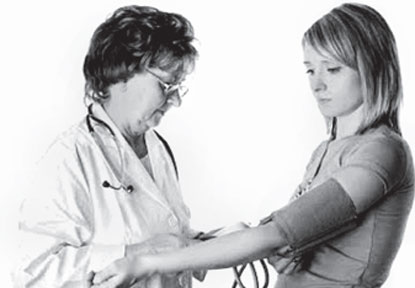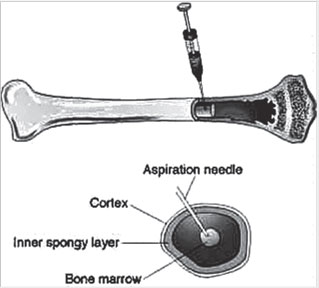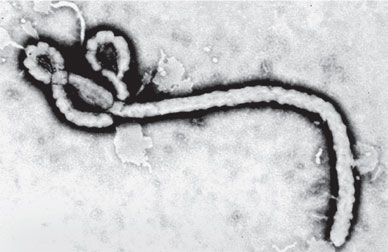|

Ensuring more accuracy for those who need treatment:
Radical change in blood pressure diagnosis
The way blood pressure is diagnosed and treated is set to be
revolutionised following new guidelines for the medical profession
developed in conjunction with the British Hypertension Society (BHS).
It will mark the first time in over a century that the way blood
pressure is routinely monitored by GPs has been changed.
 A major feature of the new guideline is the recommendation that high
blood pressure should be diagnosed using ambulatory blood pressure
monitoring, a technique in which the patient wears a monitor for 24
hours to gauge how high their blood pressure is. A major feature of the new guideline is the recommendation that high
blood pressure should be diagnosed using ambulatory blood pressure
monitoring, a technique in which the patient wears a monitor for 24
hours to gauge how high their blood pressure is.
University of Leicester Professor Bryan Williams Chaired the NICE
hypertension guideline.
He believes this new approach will mean that as many as 25% of people
diagnosed as having high blood pressure using the current method of
diagnosis, i.e. repeated measurement of blood pressure in the doctor’s
clinic, may not be hypertensive and may not need treatment.
“This new guideline is going to change the way blood pressure is
diagnosed and treated for millions of people around the world.The new
approach will be more accurate in diagnosing high blood pressure and
will ensure that the right people get treated.“We are using new
technologies to improve the way we diagnose high blood pressure.
“It means that we will be more accurate in treating those who need
treatment and in avoiding treating those who don’t.”
In accompanying research published simultaneously in the Lancet, the
guideline group demonstrated that this new approach is highly
cost-effective and even after taking account of the cost of the new
technology, is likely to be cost saving for the NHS.“Even though these
new devices cost between £1,000 - £2,000, our analyses suggest that by
improving the speed and accuracy of diagnosis, we will actually save
money by only targeting treatment at those who need and will benefit
from treatment - this is good news for patients.
I am under no illusions about the challenges to implement this but I
believe this guideline will be well received by both doctors and
patients not just in England and Wales, but worldwide,” said Professor
Williams, Professor of Medicine at the University and an honourary
consultant physician at the University Hospitals of Leicester NHS Trust.
The new guideline also simplifies the treatment strategy for high
blood pressure, focusing on the most effective treatments and also
contains specific advice on the treatment of blood pressure in young
adults and the very elderly.Professor Williams added: “We have spent
more than a year looking at masses of new evidence from studies in great
detail before coming to our conclusions.
I think the UK is leading the world in developing bold and
progressive treatment strategies for high blood pressure.
The importance of this cannot be overstated for two reasons, first
because high blood pressure is very common and affects about a quarter
of all adults and more than half of adults over the age of 60 yrs, and
second, because treating high blood pressure is one of the most
effective ways of reducing the risks of heart disease and stroke.”
Sources: Leicester University, AlphaGalileo Foundation.
Disaster looms over addiction to painkillers
The actor Heath Ledger’s autopsy concluded that he died as a result
of an ‘acute intoxication’ with a number of drugs, including the opioid
painkiller oxycodone
They are the most powerful painkillers that family doctors have at
their disposal, and as the queue of patients suffering from chronic pain
grows longer doctors have been handing them out in greater numbers.
A review by the National Treatment Agency for Substance Abuse,
published in June, found a six-fold increase in the prescribing of
opioid analgesics by GPs from 228 million items in 1991 to 1.38bn items
in 2009.
Brian Iddon, the former chairman of the All Party Parliamentary Group
on Drug Misuse, which reported in 2009, warned that the UK faced a
similar epidemic to that in North America within a decade. MesDes
Spence, a GP in Glasgow, wrote in the BMJ that the increased prescribing
of opioid for chronic pain e other than that caused by cancer - was a
“disaster in the making”.
The increase is being driven by drug-company marketing that is
fuelling patient demand.
As populations age in the UK and across Europe, and more succumb to
conditions such as arthritis, between 20 and 50 per cent are estimated
to suffer from chronic pain.
Chronic pain caused by injury or disease has been poorly treated in
the past and specialists acknowledge the growing use of powerful
painkillers is a sign of a more compassionate society, prepared to
dispense comfort to those in need. But there is a risk, as doses rise
and dependence grows, that the dangers outweigh the benefits.
The review, Addiction to Medicines, by the National Treatment Agency
for Substance Abuse, found that 3,735 patients receiving treatment for
addiction said their primary problem was with prescription medicines,
just 2 per cent of the total in drug-treatment services.But the authors
admitted that most of those with such a problem would be likely to seek
treatment from their GPs.
Breakthrough offers hope in breast cancer fight
A naturally occurring molecule in bacteria can block the development
of breast cancer, scientists have discovered, paving the way for the
design of more potent and selective drugs.
The molecule, thiostrepton, clamps FOXM1, a cancer-causing protein
present in greater amounts in breast cancer cells.
It switches on genes regulating the growth and division of cells,
causes tumours to spread and triggers the growth of blood vessels.
Blocking this protein may prevent the development of cancer at an
early stage as well as blocking its growth and spread according to the
study published in Nature Chemistry.
Its lead author, Professor Shankar Balasubramanian, based at Cancer
Research UK in Cambridge, said: “Before this research we weren’t aware
of any natural product which could directly target a protein that
controls gene activity. Yet intriguingly a molecule in bacteria û which
also has strong antibiotic effects û does this very well, switching off
cancer-causing genes in breast cancer cells.”
- The Independent
Point of entry for Ebola virus identified
Although outbreaks are rare, Ebola virus, the cause of Ebola
hemorrhagic fever (EHF), is one of the deadliest known viruses affecting
humans. According to the World Health Organisation (WHO), approximately
1,850 EHF cases with more than 1,200 deaths have been documented since
the virus was identified in 1976.
EHF’s clinical presentation can be devastating: fever, intense
weakness, and joint and muscle aches progress to diarrhea, vomiting, and
in some cases, internal and external bleeding caused by disintegrating
blood vessels. Currently, there is no approved vaccine and patients are
treated only for their symptoms. Like anthrax and smallpox virus, Ebola
virus is classified as a category A bioterrorism agent by the U.S.
Centers for Disease Control and Prevention (CDC).
Until now, however, researchers had only a limited understanding of
how Ebola virus gains entry to a host cell.
Using an unusual human cell line, scientists and collaborators have
identified the Niemann-Pick C1 (NPC1) protein as crucial for Ebola virus
to enter cells and begin replicating.
The discovery may offer a new and better approach for the development
of antiviral therapeutics, as it would target a structure in the host
cell rather than a viral component. The findings are reported online in
Nature this week.
“Right now, people make therapeutics to inactivate the pathogen
itself. But the problem is that pathogens can quickly change and escape
detection and elimination by the immune system,” says former Whitehead
Fellow Thijn Brummelkamp. “Here we get a good idea of the host genes
that are needed for the pathogen to enter the cell for replication.
Perhaps by generating therapeutics against those host factors, we would
have a more stable target for antiviral drugs.”
The method developed by the Brummelkamp lab to identify host factors
relies on gene disruption knocking out gene function in the host cells,
one gene at a time and documenting which cells survive due to mutations
that afford protection from viral entry.
But human cells are diploid with two copies of each chromosome and
its genes. Researchers can reliably target and knock out one copy of a
gene, but doing so for both copies is far more difficult and
time-consuming. If only a single copy is silenced, the other continues
to function normally and masks any effect of the knockout.
To sidestep this obstacle, Jan Carette, employed a technique he had
previously applied to study the cytolethal distending toxin (CDT) family
that is secreted by multiple pathogenic bacteria, including Escherichia
coli, Shigella dysenteriae, and Haemophilus ducreyi. Each bacterial
species has developed its own twists on the CDT structure, which may
link to the target tissues of the toxin’s bacterium.
Using this virus and by altering the haploid cells somewhat, Carette
and coauthors were able to pinpoint the cellular genes that Ebola virus
relies on to enter the cell.
Source: Whitehead Institute for Biomedical Research
The dark side of prescription drugs
Mention of drug addiction typically conjures up images of strung-out
users of heroin or crack cocaine. But a growing number of people are
dependent on legal drugs, prescribed by their doctors, with a grip as
unforgiving as that of their illegal counterparts. It is a problem that
cannot keep being ignored.
Despite the efforts of campaigners, the blight of addiction to
prescription medicines in particular opiate-based painkillers and
benzodiazepine tranquillisers - remains low on the agenda and largely
unexamined.
What glimmers of statistical light there are, are increasingly
disturbing. Opiate painkillers are being dispensed at five times the
rate they were 20 years ago, for example, while deaths involving codeine
doubled between 2005 and 2009 alone.
In part, the problem reflects patient demand. There is a growing
battery of drugs to combat anxiety and chronic pain, and sufferers are
unsurprisingly keen to make use of them. But there is a balance to be
struck. Patients may not be aware of the potency of their medication
until it is too late, while GPs too often boost doses far above
recommended levels if patients’ complaints continue.
The real worry is the unknown scale of the problem. While estimates
suggest around 1.5 million people could be hooked on their medicine, the
issue receives so little attention that there may be many more who are
unaware they have a problem, and there is little support for those that
do.
The piecemeal approach from the Department of Health so far is
insufficient. Addiction to prescription drugs needs a coordinated
response: clearer guidelines for doctors, closer monitoring of patients,
tighter controls on drug marketing, more help for addicts.
But the crucial first step, as with addiction, is to face up to the
fact there is a problem.
-The Independent
Bone marrow transplantation and cancer resistance
Bone marrow transplantation with genetically modified cells may
prolong the period of cancer-free survival, suggests a study done
recently.
Bone marrow, a spongy tissue inside bones, contains stem cells that
produce blood cells, including leukocytes, erythrocytes and platelets.
 Dr. Vivek Rangnekar and his team explore the transfer of bone marrow
from Par-4/SAC-transgenic donor mice to control mice as a means of
transferring anti-cancer potential. Par-4 (also known as PAWR) is a
tumor suppressor protein that selectively induces apoptosis in cancer
cells, but not normal cells. Dr. Vivek Rangnekar and his team explore the transfer of bone marrow
from Par-4/SAC-transgenic donor mice to control mice as a means of
transferring anti-cancer potential. Par-4 (also known as PAWR) is a
tumor suppressor protein that selectively induces apoptosis in cancer
cells, but not normal cells.
This function of Par-4 is mediated by its central core domain, SAC.
SAC-transgenic mice are resistant to the growth of spontaneous and
inducible tumors.
After transplantation, the researchers discovered the expression of
cancer-killer SAC-GFP activity in bone marrow cells of the recipient
mice, implying the successful transfer and colonisation of the
anti-cancer tissue from the donors. In addition, soluble Par-4 or SAC
protein injected into mice inhibited the growth of metastatic tumors.
Rangnekar, the Alfred Cohen Endowed Chair of Oncology Research at
Markey, says the study shows promise for treating both primary and
metastatic tumors.
“We are excited by the findings of this study as they indicate that
secreted Par-4 is systemically active in mice,” Rangnekar said.
“Optimization of the bone marrow transplantation procedure using stem
cells that are genetically modified to systemically secrete potent
protein payloads of Par-4/SAC killer activity may offer a new approach
to treat not only primary tumors but also metastatic tumors of diverse
origin.”
Source: University of Kentucky
Diversified diets and food sources
Diversified diet will improve health and it will protect us from
certain bone diseases. Therefore, we should be aware of those nutrients.
So, what are those nutrients and their food sources?
* Calcium is the major nutrient that is responsible for bone
formation. However, it is essential to take more calcium during
childhood and adolescence, because, during 16-18 years bones reaches to
its peak bone mass. Milk and other dairy products such as cheese,
yoghurt etc. as well as small fish, canned fish, beans, spinach, sweet
potato, pulses, nuts and cereals contain calcium.
 * Phosphorus is important for bone formation. Many foods contain
phosphorus. Among those foods, animal foods such as meat, poultry, fish
as well as grain products are rich in phosphorus. However, this mineral
lacks in milk and other dairy products although they are rich in
calcium. * Phosphorus is important for bone formation. Many foods contain
phosphorus. Among those foods, animal foods such as meat, poultry, fish
as well as grain products are rich in phosphorus. However, this mineral
lacks in milk and other dairy products although they are rich in
calcium.
* Vitamin D regulates bone calcium absorption and resorption when
change the blood calcium level. Sunlight is the main source of vitamin D
for us as Sri Lankans. Herrings, sardine and fish liver oil are good
animal sources while small portions of vitamin D can be taken from eggs,
veal, beef, butter and vegetable oils. However, plants, fruits, and nuts
are poor sources of vitamin D.
* Vitamin A involves in bone remodelling. Richest sources of vitamin
A are fish oils, liver and other organ meats. Full-cream milk, butter,
fortified margarine are also rich in vitamin A. Dark green leafy
vegetables, carrots and deep orange sweet potato are plant sources.
* Vitamin K produces bone proteins. They involve in bone formation
and in bone metabolism. This vitamin is found only in limited number of
foods such as dark green leafy vegetables, spinach, cabbage, soy oil and
certain types of cheese.
* Vitamin C stimulates collagen formation that is responsible for
bone matrix formation. Fresh fruits and vegetables are rich in vitamin
C.
To improve the bone health it is very much important to concern on
food intake as well as physical activities. For that, should have
diversified diet. That means foods that we take per day should consist
of cereals or starchy roots, legumes, vegetables, fruits, milk and milk
products, meat or fish. This type of diet will provide you with required
types of nutrients and improve your bone health.
In contrast, diversified diet is not enough. With that, it is
essential to do enough physical activities such as playing, running,
swimming etc.
It will improve absorption of nutrients and improve proper
functioning of bones. Smoking and excessive alcohol intake also badly
affect on your bone health.
Therefore, prevent from bone diseases by improving your bone health
through intake of diversified diets with sufficient level of physical
activities and by following good lifestyle patterns. To do this do not
wait until you become an adult, from the childhood practise good habits.
- Madusha Wijesinghe, Wayamba University.
|

